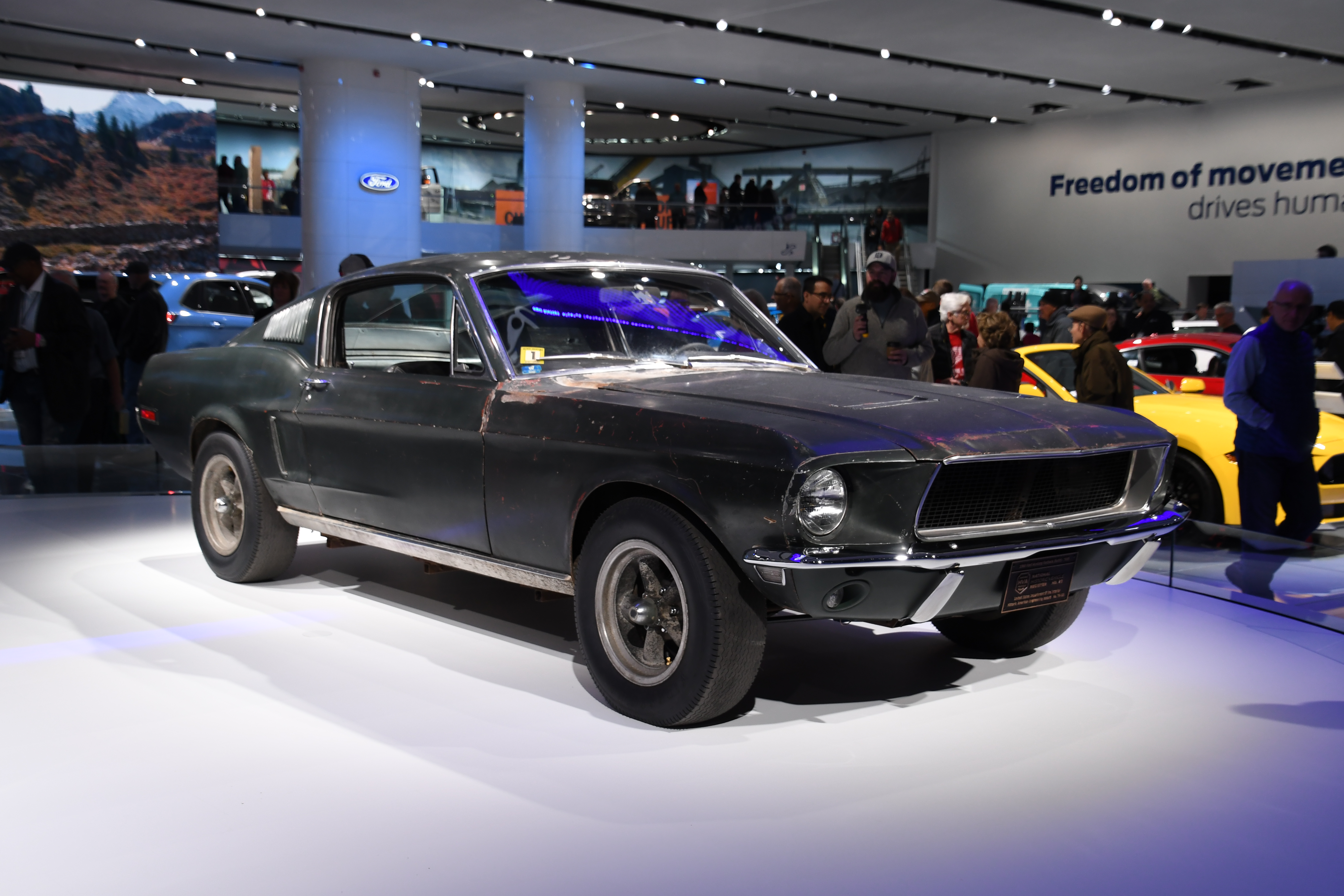
In the annals of cinematic and automotive history, few vehicles command the reverence and mystique of Steve McQueen’s 1968 Ford Mustang GT Fastback from the film “Bullitt.” It’s more than just a car; it’s a co-star, a character as indelible as McQueen himself, forever etched into the collective consciousness as a symbol of cool, grit, and unparalleled cinematic action. The story behind this dark green machine is as layered and compelling as the San Francisco hills it famously conquered, a narrative woven with passion, innovation, and a touch of serendipitous fate.
This isn’t merely a tale of a movie prop; it’s an exploration into the meticulous craftsmanship, strategic foresight, and sheer audacious spirit that coalesced to create an icon. From the moment it roared onto the screen, the Bullitt Mustang transcended its original purpose, morphing from a mere promotional vehicle into a cultural touchstone that ignited the imaginations of millions and redefined the very essence of the Hollywood car chase. Its journey, marked by both deliberate design and unexpected turns, continues to captivate, offering a rare glimpse into the intersection of artistry, engineering, and sheer star power.
Join us as we peel back the layers of varnish and legend, delving deep into the six factual pillars that underpin the Mustang’s extraordinary narrative. We’ll trace its origins, unravel the genius behind its on-screen persona, and follow the astonishing paths of the two original cars, revealing the intricate details that cemented its place not just in film, but in the heart of automotive enthusiasts worldwide. Prepare to discover the meticulous research and dramatic narrative that shaped one of the greatest automotive legends of all time.
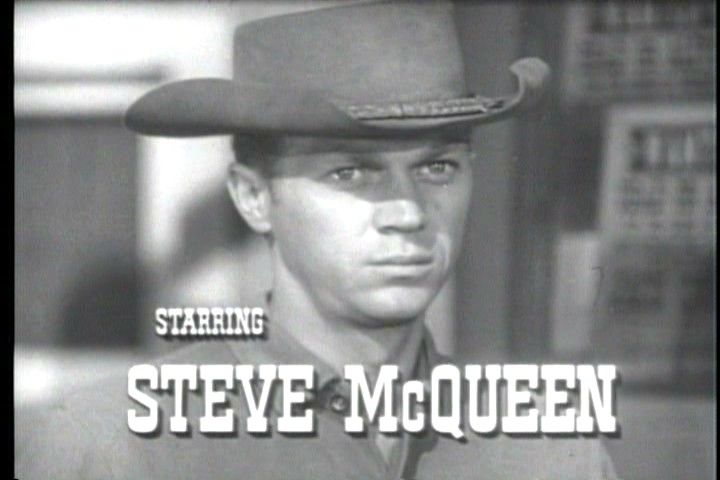
1. **Steve McQueen: The Racer-Actor Behind the Wheel**Steve McQueen was not merely an actor who occasionally dabbled in motorsport; he was, by his own admission, profoundly torn between his two passions. He famously articulated this internal conflict, stating, “I’m not sure whether I’m an actor who races or a racer who acts.” This sentiment perfectly encapsulated the essence of a man whose raw talent and genuine love for speed often blurred the lines between his professional and personal lives.
Indeed, McQueen’s commitment to racing was far from a dilettantish hobby. He competed under the amusing pseudonym Harvey Mushman, a testament to his desire for a degree of anonymity amidst his celebrity. His prowess on the track was undeniable, exemplified by his remarkable second-place finish in the 1970 12 Hours of Sebring. This achievement was made even more astounding by the fact that he was still recovering from a broken foot, an injury sustained just two weeks prior in a motocross race, underscoring his fierce determination and resilience.
His racing pedigree and insistence on authenticity were crucial to the “Bullitt” car chase’s legendary status. McQueen was intimately involved in the scene’s development, pushing for realism over exaggerated stunts, a revolutionary approach for its time. He wasn’t just playing a role; he was embodying his true self, an authentic racer behind the wheel, making the on-screen spectacle all the more visceral and believable. This fusion of his acting talent and racing expertise created a magical synergy, turning smoking rubber and power slides into a glorious, unforgettable cinematic experience.
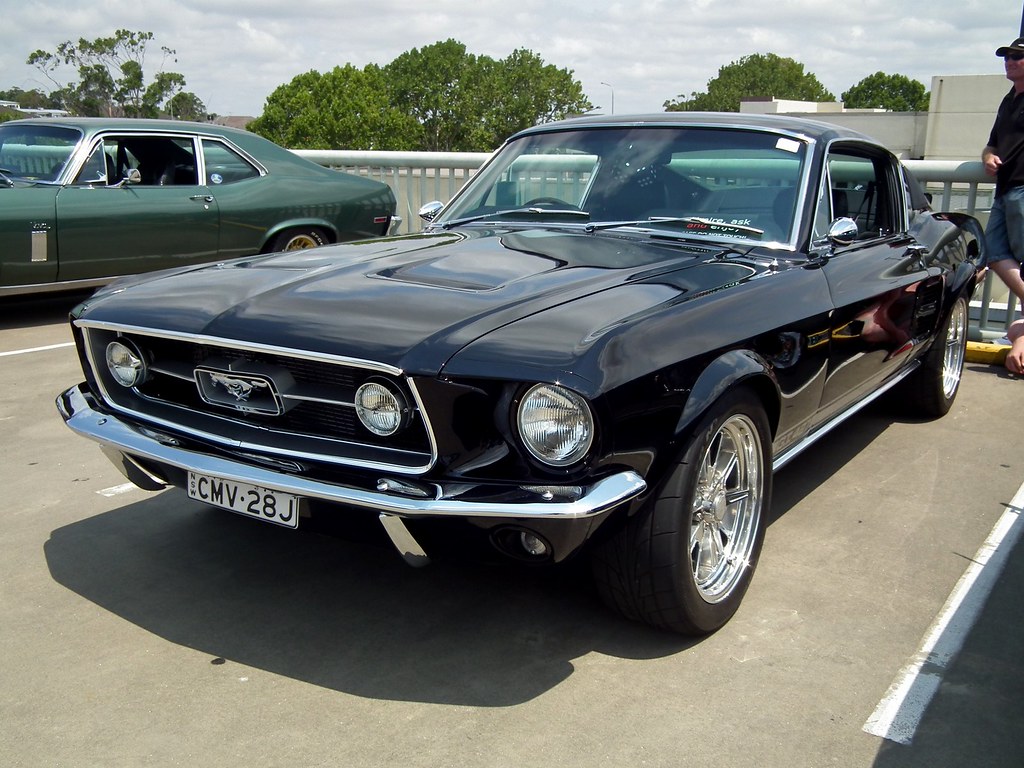
2. **Ford’s Masterstroke: The Mustang as a Promotional Icon**The Ford Mustang had already irrevocably altered the landscape of American performance cars with its debut in April of 1964, igniting an unprecedented demand for lightweight American coupes equipped with potent V8 engines. However, by February 1968, as filming for “Bullitt” commenced, Ford found itself locked in an intense battle for market dominance, facing formidable new competition. The generational refresh the c received in 1967, while appreciated, was relatively minor compared to the impactful introduction of General Motors’ all-new Chevrolet Camaro and Pontiac Firebird, which were aggressively stealing the automotive limelight.
In this fiercely competitive environment, Ford desperately needed a compelling way to recapture public attention and reassert the Mustang’s preeminence. The opportunity presented by “Bullitt” was nothing short of a divine intervention. What could be more effective than featuring an authentic racer and leading man, none other than Steve McQueen, orchestrating an epic car chase through the iconic, undulating streets of San Francisco, all from behind the wheel of a Mustang, showcased on movie screens nationwide?
This calculated promotional ploy proved to be an unparalleled success, far exceeding anyone’s wildest expectations. The potent combination of McQueen’s star power and the rugged allure of the 1968 Mustang became so iconic that the automotive community almost immediately bestowed upon the 1968 Mustang Fastback the moniker “‘Bullitt Mustang,”‘ effectively overshadowing the rest of the film in the popular imagination. The enduring question of whether another vehicle, such as a Plymouth Road Runner or a Porsche 911, could have achieved the same profound impact on car enthusiasts’ psyches remains purely speculative. The point, ultimately, is moot because Ford sought a promotional vehicle, and in the Bullitt Mustang, they secured an icon that continues to resonate decades later.
Car Model Information: 2016 Ford Mustang GT
Name: Ford Mustang
Caption: 2018 Ford Mustang GT 5.0
Aka: Ford T5 (Germany)
Manufacturer: Ford Motor Company
Production: March 1964 – present
ModelYears: 1965–present
Class: Unbulleted list
BodyStyle: Unbulleted list
Layout: Front-engine, rear-wheel-drive layout
Categories: 1970s cars, 1980s cars, 1990s cars, 2+2 coupés, 2000s cars
Summary: The Ford Mustang is an American automobile manufactured and marketed by Ford since 1964, as Ford’s longest nameplate in continuous production. Currently in its seventh generation, it is the fifth-best selling Ford car nameplate. The namesake of the “pony car” automobile segment, the Mustang was developed as a highly styled line of sporty coupes and convertibles derived from existing model lines, initially distinguished by its pronounced “long hood, short deck” proportions.
Originally predicted to sell 100,000 vehicles yearly, the 1965 Mustang became the most successful vehicle launch since the 1927 Model A. Introduced on April 17, 1964 (16 days after the Plymouth Barracuda), over 400,000 units were sold in its first year; the one-millionth Mustang was sold within two years of its launch. In August 2018, Ford produced the 10-millionth Mustang; matching the first 1965 Mustang, the vehicle was a 2019 Wimbledon White convertible with a V8 engine.
The success of the Mustang launch led to multiple competitors from other American manufacturers, including the Chevrolet Camaro and Pontiac Firebird (1967), AMC Javelin (1968), and Dodge Challenger (1970). It also competed with the Plymouth Barracuda, which was launched around the same time. The Mustang also had an effect on designs of coupes worldwide, leading to the marketing of the Toyota Celica and Ford Capri in the United States (the latter, by Lincoln-Mercury). The Mercury Cougar was launched in 1967 as a unique-bodied higher-trim alternative to the Mustang; during the 1970s, it included more features and was marketed as a personal luxury car.
From 1965 until 2004, the Mustang shared chassis commonality with other Ford model lines, staying rear-wheel-drive throughout its production. From 1965 to 1973, the Mustang was derived from the 1960 Ford Falcon compact. From 1974 until 1978, the Mustang (denoted Mustang II) was a longer-wheelbase version of the Ford Pinto. From 1979 until 2004, the Mustang shared its Fox platform chassis with 14 other Ford vehicles (becoming the final one to use the Fox architecture). Since 2005, the Mustang has used the D2C platform, unique to the Mustang.
Through its production, multiple nameplates have been associated with the Ford Mustang series, including GT, Mach 1, Boss 302/429, Cobra (separate from Shelby Cobra), and Bullitt, along with “5.0” fender badging (denoting 4.9 L OHV or 5.0 L DOHC V8 engines).
Get more information about: Ford Mustang
Buying a high-performing used car >>>
Brand: Ford Model: Mustang
Price: $29,261 Mileage: 24,710 mi.
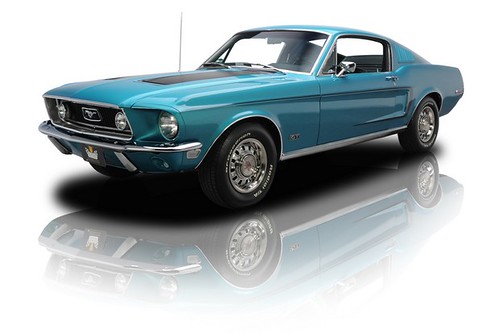
3. **The Chosen Steed: Specifications of the 1968 GT Fastback 390**The genesis of the Bullitt Mustang began with a pragmatic decision by Warner Bros. After determining that a Mustang would be Frank Bullitt’s vehicle of choice, the studio placed an order with Ford for a pair of Mustang Fastbacks. The specific model selected as the foundation for these cinematic heroes was the 1968 GT, a formidable choice that came with a suite of performance-oriented features already integrated as part of its standard GT package.
This package was crucial for the strenuous demands of filming, automatically equipping the cars with essential upgrades such as power disc brakes, ensuring reliable stopping power during high-speed maneuvers. It also included whitewall nylon tires, though these would soon be swapped for more menacing alternatives, and an upgraded cooling package, vital for withstanding the intense heat generated during relentless chase sequences. These foundational elements provided a robust platform for the subsequent modifications.
Under the hood, buyers of the 1968 GT could specify their preference for either a two- or four-barrel carburetor, both mounted on a potent 390-cubic-inch engine. Depending on this setup, the stock GT was capable of generating a substantial output ranging between 270 and 325 horsepower. The two specific cars purchased by Warner Bros. carried back-to-back serial numbers: 8R02S125558, often referred to simply as ‘558, and 8R02S125559, or ‘559. These unique identifiers would become crucial in tracing the cars’ extraordinary individual destinies, forever linking them to the cinematic legend they helped create.
Car Model Information: 2016 Ford Mustang GT
Name: Ford Mustang
Caption: 2018 Ford Mustang GT 5.0
Aka: Ford T5 (Germany)
Manufacturer: Ford Motor Company
Production: March 1964 – present
ModelYears: 1965–present
Class: Unbulleted list
BodyStyle: Unbulleted list
Layout: Front-engine, rear-wheel-drive layout
Categories: 1970s cars, 1980s cars, 1990s cars, 2+2 coupés, 2000s cars
Summary: The Ford Mustang is an American automobile manufactured and marketed by Ford since 1964, as Ford’s longest nameplate in continuous production. Currently in its seventh generation, it is the fifth-best selling Ford car nameplate. The namesake of the “pony car” automobile segment, the Mustang was developed as a highly styled line of sporty coupes and convertibles derived from existing model lines, initially distinguished by its pronounced “long hood, short deck” proportions.
Originally predicted to sell 100,000 vehicles yearly, the 1965 Mustang became the most successful vehicle launch since the 1927 Model A. Introduced on April 17, 1964 (16 days after the Plymouth Barracuda), over 400,000 units were sold in its first year; the one-millionth Mustang was sold within two years of its launch. In August 2018, Ford produced the 10-millionth Mustang; matching the first 1965 Mustang, the vehicle was a 2019 Wimbledon White convertible with a V8 engine.
The success of the Mustang launch led to multiple competitors from other American manufacturers, including the Chevrolet Camaro and Pontiac Firebird (1967), AMC Javelin (1968), and Dodge Challenger (1970). It also competed with the Plymouth Barracuda, which was launched around the same time. The Mustang also had an effect on designs of coupes worldwide, leading to the marketing of the Toyota Celica and Ford Capri in the United States (the latter, by Lincoln-Mercury). The Mercury Cougar was launched in 1967 as a unique-bodied higher-trim alternative to the Mustang; during the 1970s, it included more features and was marketed as a personal luxury car.
From 1965 until 2004, the Mustang shared chassis commonality with other Ford model lines, staying rear-wheel-drive throughout its production. From 1965 to 1973, the Mustang was derived from the 1960 Ford Falcon compact. From 1974 until 1978, the Mustang (denoted Mustang II) was a longer-wheelbase version of the Ford Pinto. From 1979 until 2004, the Mustang shared its Fox platform chassis with 14 other Ford vehicles (becoming the final one to use the Fox architecture). Since 2005, the Mustang has used the D2C platform, unique to the Mustang.
Through its production, multiple nameplates have been associated with the Ford Mustang series, including GT, Mach 1, Boss 302/429, Cobra (separate from Shelby Cobra), and Bullitt, along with “5.0” fender badging (denoting 4.9 L OHV or 5.0 L DOHC V8 engines).
Get more information about: Ford Mustang
Buying a high-performing used car >>>
Brand: Ford Model: Mustang
Price: $29,261 Mileage: 24,710 mi.
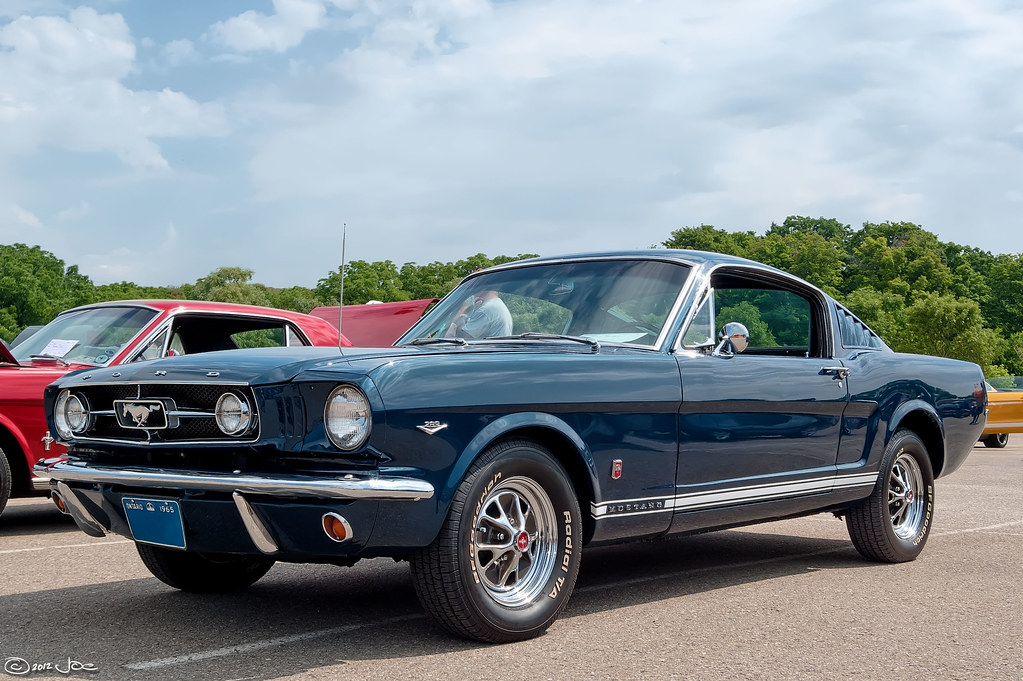
4. **Max Balchowsky’s Alchemy: Mechanical and Aesthetic Transformations**To transform the brand-new 1968 GT Fastbacks into the gritty, battle-hardened machine Frank Bullitt would pilot, the studio applied a series of deliberate and calculated changes. Aesthetically, the cars received a weathered patina, a subtle but critical detail that lent them an understated, quasi-menacing appearance perfectly suited to the stoic demeanor of Lieutenant Bullitt. This involved applying scuffs to the signature Dark Highland Green paint, even though the vehicles were fresh from the factory, and painting the gas caps black to further enhance their clandestine allure.
The real heavy lifting, however, came in the mechanical department, expertly handled by Max Balchowsky, a renowned stuntman and race driver retained by the studio. Balchowsky’s modifications were extensive and designed to ensure the Mustangs could endure the brutal abuse of the demanding chase scenes. He replaced the stock transmission with an aftermarket four-speed manual transmission and clutch, providing the drivers with precise control crucial for the intense choreography.
Beyond the drivetrain, Balchowsky reinforced the cars structurally, installing crossbeam stabilizers and multiple reinforcements to both the frame and springs. These enhancements were vital for absorbing the tremendous impacts and stresses placed on the chassis during the numerous jumps and high-speed maneuvers that would define the chase. Additionally, Koni adjustable shocks were installed, allowing for fine-tuning of the suspension to meet the specific requirements of various stunts. The stock exhaust systems retained their small glasspack mufflers but saw the transverse muffler removed in favor of straight pipes out the back, a modification primarily done to amplify the guttural roar of the 390 V8, enhancing the auditory experience for moviegoers. The cars were also stripped of all badging, various chrome pieces were painted black or body color, and the grille-mounted horse emblem and driving lights were removed, culminating in a lean, aggressive, and utterly unforgettable visual identity, further accentuated by swapping the stock steering wheel for a 1967 Shelby piece, custom-wrapped in leather by McQueen’s pal Tony Nancy.
Car Model Information: 2018 Chevrolet Corvette Grand Sport
Name: Mustang (first generation)
Caption: 1965 Ford Mustang
Aka: Ford T5 (Germany)
Manufacturer: Ford Motor Company
Assembly: Unbulleted list
Production: March 1964 – June 1973
ModelYears: 1965–1973
Class: Unbulleted list
BodyStyle: Unbulleted list
Layout: Front-engine, rear-wheel drive layout
Designer: Gale Halderman
Related: Unbulleted list
Successor: Ford Mustang (second generation)
Categories: 1970s cars, All Wikipedia articles written in American English, All articles with unsourced statements, Articles with short description, Articles with unsourced statements from January 2020
Summary: The first-generation Ford Mustang was manufactured by Ford from March 1964 until 1973. The introduction of the Mustang created a new class of automobiles known as pony cars. The Mustang’s styling, with its long hood and short deck, proved wildly popular and inspired a host of competition.
It was introduced on April 17, 1964, as a hardtop and convertible, with the fastback version following in August 1964. Upon introduction, the Mustang, sharing its platform with the Falcon, was slotted into the compact car segment.
The first-generation Mustangs grew in overall dimensions and engine power with each revision. The 1971 model featured a drastic redesign. After an initial surge, sales steadily declined, and Ford began working on a new generation Mustang. With the onset of the 1973 oil crisis, Ford was prepared, having already designed the smaller Mustang II for the 1974 model year. This new car shared no components with preceding models.
Get more information about: Ford Mustang (first generation)
Buying a high-performing used car >>>
Brand: Ford Model: Mustang GT Fastback
Price: $59,896 Mileage: 26,662 mi.
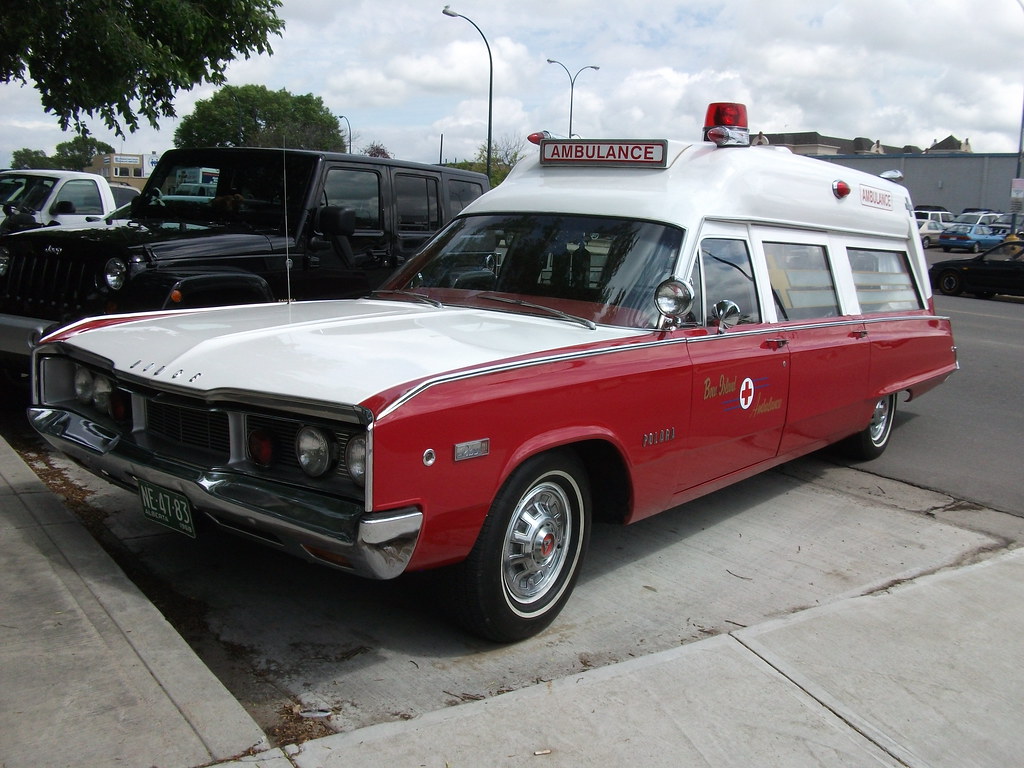
5. **A Cinematic Revolution: The 11-Minute San Francisco Chase**The cool factor imparted by Max Balchowsky’s meticulous modifications played a significant role, but it was the car chase scene itself that truly forged the Bullitt Mustang’s enduring reputation. Within the film, the sequence sees Frank Bullitt, in his iconic Mustang, relentlessly pursuing a bad guy driving a menacing black 1968 Dodge Charger R/T. This ensuing pursuit wasn’t just a brief interlude; it consumed nearly 11 minutes of screen time in a film that ran less than two hours, a staggering proportion for its era and a testament to its pivotal role in the narrative and its revolutionary impact on cinema.
What made this chase uniquely riveting was the production’s unwavering insistence on realism, a pioneering approach that set it apart from its contemporaries. This commitment extended to every detail, including the audacious decision to stage the entire pursuit on the actual, treacherous city streets of San Francisco, a move that immersed audiences in the raw, unadulterated chaos. Furthermore, the scene masterfully utilized interior points-of-view, a technique then largely underutilized in cinema, with some contemporary viewers reportedly experiencing motion sickness due to the visceral nature of the shots, truly placing them in the driver’s seat alongside McQueen.
The meticulous sound design further enhanced this realism, incorporating audio lifted directly from recordings of racing engines and the authentic sounds of McQueen shifting gears, captured with recording equipment deliberately placed in the cockpit. The scene builds tension with masterful pacing, starting slowly as McQueen subtly tails the Charger, but erupting into full-blown mayhem around the three-minute mark when the baddies fasten their lap-only seatbelts. The cacophony of screeching tires, the authentic depiction of everyday traffic, and the breathtaking, albeit dangerous, San Francisco scenery all converged to create a potent and unforgettable spectacle, making it the definitive muscle-car chase in cinematic history.
Car Model Information: 2016 Ford Mustang GT
Name: Ford Mustang
Caption: 2018 Ford Mustang GT 5.0
Aka: Ford T5 (Germany)
Manufacturer: Ford Motor Company
Production: March 1964 – present
ModelYears: 1965–present
Class: Unbulleted list
BodyStyle: Unbulleted list
Layout: Front-engine, rear-wheel-drive layout
Categories: 1970s cars, 1980s cars, 1990s cars, 2+2 coupés, 2000s cars
Summary: The Ford Mustang is an American automobile manufactured and marketed by Ford since 1964, as Ford’s longest nameplate in continuous production. Currently in its seventh generation, it is the fifth-best selling Ford car nameplate. The namesake of the “pony car” automobile segment, the Mustang was developed as a highly styled line of sporty coupes and convertibles derived from existing model lines, initially distinguished by its pronounced “long hood, short deck” proportions.
Originally predicted to sell 100,000 vehicles yearly, the 1965 Mustang became the most successful vehicle launch since the 1927 Model A. Introduced on April 17, 1964 (16 days after the Plymouth Barracuda), over 400,000 units were sold in its first year; the one-millionth Mustang was sold within two years of its launch. In August 2018, Ford produced the 10-millionth Mustang; matching the first 1965 Mustang, the vehicle was a 2019 Wimbledon White convertible with a V8 engine.
The success of the Mustang launch led to multiple competitors from other American manufacturers, including the Chevrolet Camaro and Pontiac Firebird (1967), AMC Javelin (1968), and Dodge Challenger (1970). It also competed with the Plymouth Barracuda, which was launched around the same time. The Mustang also had an effect on designs of coupes worldwide, leading to the marketing of the Toyota Celica and Ford Capri in the United States (the latter, by Lincoln-Mercury). The Mercury Cougar was launched in 1967 as a unique-bodied higher-trim alternative to the Mustang; during the 1970s, it included more features and was marketed as a personal luxury car.
From 1965 until 2004, the Mustang shared chassis commonality with other Ford model lines, staying rear-wheel-drive throughout its production. From 1965 to 1973, the Mustang was derived from the 1960 Ford Falcon compact. From 1974 until 1978, the Mustang (denoted Mustang II) was a longer-wheelbase version of the Ford Pinto. From 1979 until 2004, the Mustang shared its Fox platform chassis with 14 other Ford vehicles (becoming the final one to use the Fox architecture). Since 2005, the Mustang has used the D2C platform, unique to the Mustang.
Through its production, multiple nameplates have been associated with the Ford Mustang series, including GT, Mach 1, Boss 302/429, Cobra (separate from Shelby Cobra), and Bullitt, along with “5.0” fender badging (denoting 4.9 L OHV or 5.0 L DOHC V8 engines).
Get more information about: Ford Mustang
Buying a high-performing used car >>>
Brand: Ford Model: Mustang
Price: $29,261 Mileage: 24,710 mi.

6. **The Unsung Heroes: Stunt Drivers and the Quest for Realism**Steve McQueen’s unwavering commitment to authenticity was a cornerstone of the Bullitt chase’s legendary status. He famously insisted that the Mustang’s windows remain open during filming, a deliberate choice aimed at allowing moviegoers to clearly see that it was indeed him, the star, behind the wheel, actively engaged in the high-stakes pursuit. This personal involvement lent an unparalleled layer of credibility and immediacy to the action, drawing audiences deeper into the visceral experience of the chase.
However, the sheer danger and complexity of some of the more audacious stunts necessitated the expertise of seasoned professionals. While McQueen performed a significant portion of the driving, he did not pilot the Mustang for the entire chase. He received invaluable assistance from master stunt drivers such as Bud Ekins, who famously performed the dangerous motorcycle jump scene for McQueen in “The Great Escape,” and Carey Loftin, another titan of the stunt world. These individuals executed the riskiest passages, ensuring both the safety of the crew and the breathtaking quality of the cinematography.
Preparation for the intense stunt work was rigorous and meticulous. Ekins and McQueen, driven by a shared pursuit of perfection and realism, spent considerable time practicing at a nearby racetrack. There, they honed their skills, driving side-by-side at speeds exceeding 100 mph, mastering the precise timing and coordination required for the demanding on-screen choreography. This dedication ensured that when the cameras rolled, every drift, every jump, and every near-miss was executed with breathtaking precision.
Despite the meticulous planning and execution, the chase scene is famously peppered with a few “charming continuity goofs.” Sharp-eyed viewers might notice the Charger inexplicably losing six hub caps throughout the sequence, or the uncanny recurrence of the same VW Beetle popping up in multiple shots. While these minor inconsistencies are often highlighted in playful jest, they ultimately serve as endearing footnotes, never detracting from the groundbreaking authenticity and raw power of the ten iconic minutes that defined the Big Fat Car Chase, forever enshrining the Bullitt Mustang in cinematic glory.
Car Model Information: 2016 Ford Mustang GT
Name: Ford Mustang
Caption: 2018 Ford Mustang GT 5.0
Aka: Ford T5 (Germany)
Manufacturer: Ford Motor Company
Production: March 1964 – present
ModelYears: 1965–present
Class: Unbulleted list
BodyStyle: Unbulleted list
Layout: Front-engine, rear-wheel-drive layout
Categories: 1970s cars, 1980s cars, 1990s cars, 2+2 coupés, 2000s cars
Summary: The Ford Mustang is an American automobile manufactured and marketed by Ford since 1964, as Ford’s longest nameplate in continuous production. Currently in its seventh generation, it is the fifth-best selling Ford car nameplate. The namesake of the “pony car” automobile segment, the Mustang was developed as a highly styled line of sporty coupes and convertibles derived from existing model lines, initially distinguished by its pronounced “long hood, short deck” proportions.
Originally predicted to sell 100,000 vehicles yearly, the 1965 Mustang became the most successful vehicle launch since the 1927 Model A. Introduced on April 17, 1964 (16 days after the Plymouth Barracuda), over 400,000 units were sold in its first year; the one-millionth Mustang was sold within two years of its launch. In August 2018, Ford produced the 10-millionth Mustang; matching the first 1965 Mustang, the vehicle was a 2019 Wimbledon White convertible with a V8 engine.
The success of the Mustang launch led to multiple competitors from other American manufacturers, including the Chevrolet Camaro and Pontiac Firebird (1967), AMC Javelin (1968), and Dodge Challenger (1970). It also competed with the Plymouth Barracuda, which was launched around the same time. The Mustang also had an effect on designs of coupes worldwide, leading to the marketing of the Toyota Celica and Ford Capri in the United States (the latter, by Lincoln-Mercury). The Mercury Cougar was launched in 1967 as a unique-bodied higher-trim alternative to the Mustang; during the 1970s, it included more features and was marketed as a personal luxury car.
From 1965 until 2004, the Mustang shared chassis commonality with other Ford model lines, staying rear-wheel-drive throughout its production. From 1965 to 1973, the Mustang was derived from the 1960 Ford Falcon compact. From 1974 until 1978, the Mustang (denoted Mustang II) was a longer-wheelbase version of the Ford Pinto. From 1979 until 2004, the Mustang shared its Fox platform chassis with 14 other Ford vehicles (becoming the final one to use the Fox architecture). Since 2005, the Mustang has used the D2C platform, unique to the Mustang.
Through its production, multiple nameplates have been associated with the Ford Mustang series, including GT, Mach 1, Boss 302/429, Cobra (separate from Shelby Cobra), and Bullitt, along with “5.0” fender badging (denoting 4.9 L OHV or 5.0 L DOHC V8 engines).
Get more information about: Ford Mustang
Buying a high-performing used car >>>
Brand: Ford Model: Mustang
Price: $29,261 Mileage: 24,710 mi.
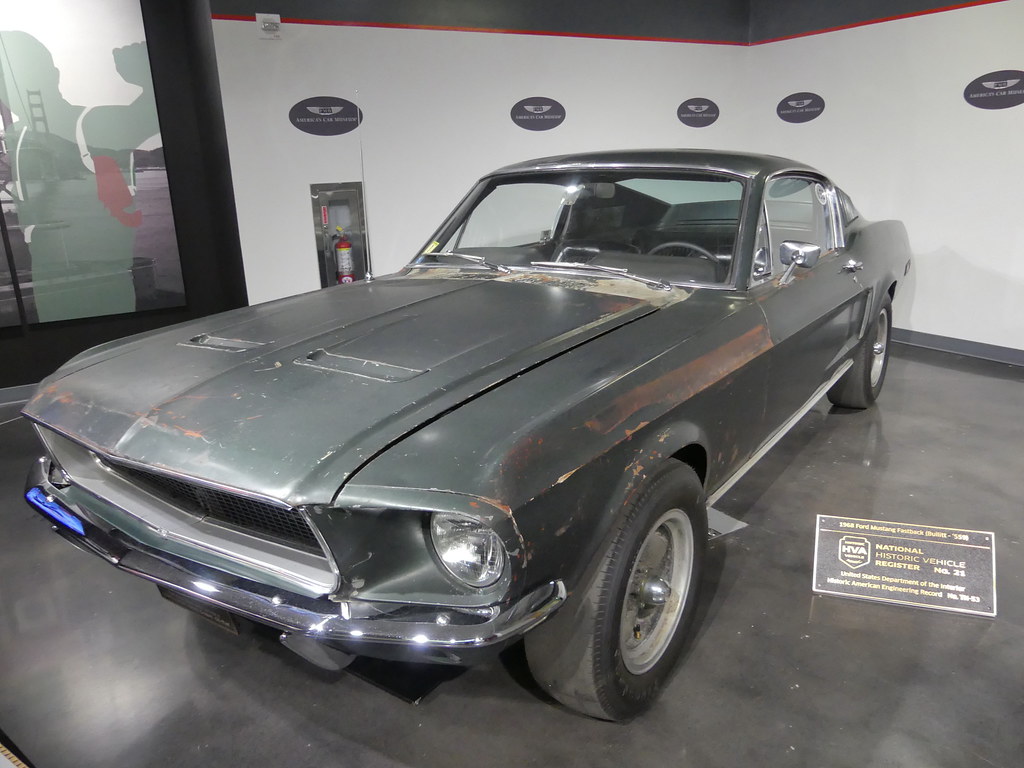
7. **The Enigma of ‘558: From Salvage Yard to Mexican Hideaway**Of the two authentic Bullitt Mustangs created for the film, their fates diverged dramatically, shaping legends of their own. One of the originals, known by its VIN ‘558, was subjected to the most intense rigors of filming, particularly the demanding jump shots. As a result of this brutal treatment, the car was essentially destroyed during production and subsequently dispatched to a salvage yard, its story seemingly concluded, a mere casualty of cinematic ambition. For decades, its whereabouts remained a tantalizing mystery, a lost piece of automotive history.
However, the story of ‘558 took an extraordinary turn in 2017 when Kevin Marti, a renowned car-restoration guru and Ford specialty shop owner in Phoenix, received a fateful phone call. The caller, a custom-Mustang builder named Ralph Garcia Jr., sought Marti’s expertise for a report to match a serial number, hoping to build a clone of the “Eleanor Mustang” from “Gone in 60 Seconds.” What Garcia didn’t realize was the profound significance of the serial number he provided.
Marti, possessing an encyclopedic knowledge of Ford VINs, instantly recognized the number – he had committed it to memory. After cautiously inquiring if Garcia had the car in hand, Marti gently broke the news of what he was actually sitting on, advising him to have an expert scrutinize it before proceeding with any modifications. Sensing the magnitude of the discovery, Marti promptly booked a ticket to Mexicali, Mexico, where Garcia’s car was located.
Upon inspection, the car was indeed in rough shape, bearing the scars of its cinematic past through impacts from jumps and the general abuse it endured during filming. It even still had the old camera mounts attached, undeniable proof of its identity. Though it lacked a drivetrain and interior and had been painted over multiple times, Marti was able to definitively confirm its authenticity via the vehicle identification number. Once Marti verified it was the genuine article, Garcia’s plans pivoted dramatically; what was intended as an “Eleanor” clone for an American customer was suddenly transformed into the restoration opportunity of a lifetime – the rediscovery of the legendary ‘558, the missing Bullitt Mustang.
Car Model Information: 2008 Ford Mustang GT Premium
Name: Ford Mustang
Caption: 2018 Ford Mustang GT 5.0
Aka: Ford T5 (Germany)
Manufacturer: Ford Motor Company
Production: March 1964 – present
ModelYears: 1965–present
Class: Unbulleted list
BodyStyle: Unbulleted list
Layout: Front-engine, rear-wheel-drive layout
Categories: 1970s cars, 1980s cars, 1990s cars, 2+2 coupés, 2000s cars
Summary: The Ford Mustang is an American automobile manufactured and marketed by Ford since 1964, as Ford’s longest nameplate in continuous production. Currently in its seventh generation, it is the fifth-best selling Ford car nameplate. The namesake of the “pony car” automobile segment, the Mustang was developed as a highly styled line of sporty coupes and convertibles derived from existing model lines, initially distinguished by its pronounced “long hood, short deck” proportions.
Originally predicted to sell 100,000 vehicles yearly, the 1965 Mustang became the most successful vehicle launch since the 1927 Model A. Introduced on April 17, 1964 (16 days after the Plymouth Barracuda), over 400,000 units were sold in its first year; the one-millionth Mustang was sold within two years of its launch. In August 2018, Ford produced the 10-millionth Mustang; matching the first 1965 Mustang, the vehicle was a 2019 Wimbledon White convertible with a V8 engine.
The success of the Mustang launch led to multiple competitors from other American manufacturers, including the Chevrolet Camaro and Pontiac Firebird (1967), AMC Javelin (1968), and Dodge Challenger (1970). It also competed with the Plymouth Barracuda, which was launched around the same time. The Mustang also had an effect on designs of coupes worldwide, leading to the marketing of the Toyota Celica and Ford Capri in the United States (the latter, by Lincoln-Mercury). The Mercury Cougar was launched in 1967 as a unique-bodied higher-trim alternative to the Mustang; during the 1970s, it included more features and was marketed as a personal luxury car.
From 1965 until 2004, the Mustang shared chassis commonality with other Ford model lines, staying rear-wheel-drive throughout its production. From 1965 to 1973, the Mustang was derived from the 1960 Ford Falcon compact. From 1974 until 1978, the Mustang (denoted Mustang II) was a longer-wheelbase version of the Ford Pinto. From 1979 until 2004, the Mustang shared its Fox platform chassis with 14 other Ford vehicles (becoming the final one to use the Fox architecture). Since 2005, the Mustang has used the D2C platform, unique to the Mustang.
Through its production, multiple nameplates have been associated with the Ford Mustang series, including GT, Mach 1, Boss 302/429, Cobra (separate from Shelby Cobra), and Bullitt, along with “5.0” fender badging (denoting 4.9 L OHV or 5.0 L DOHC V8 engines).
Get more information about: Ford Mustang
Buying a high-performing used car >>>
Brand: Ford Model: Mustang
Price: $16,785 Mileage: 81,832 mi.
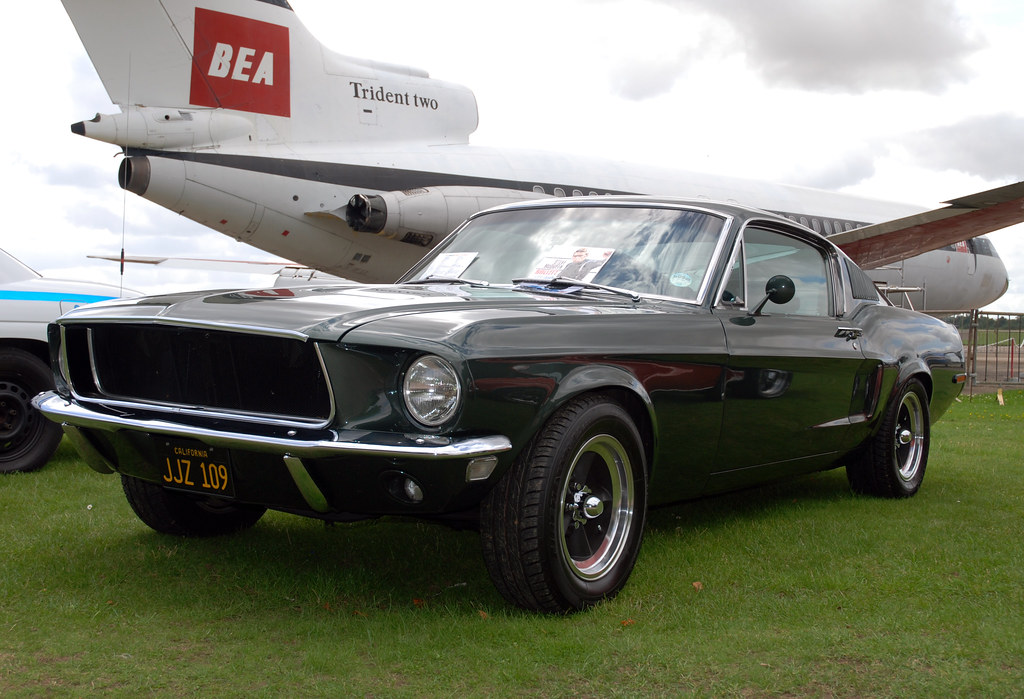
8. **The Resurface of ‘559: From Daily Driver to Automotive Royalty**While ‘558 endured a dramatic and rugged existence before its rediscovery, the second original Bullitt Mustang, bearing the VIN ‘559, embarked on an equally fascinating but far more clandestine journey. After filming concluded, this “hero” car, the one actually driven by Steve McQueen for many of the less dangerous scenes, was sold to a Warner Bros. employee named Robert Ross. It then changed hands again in 1970, purchased by a New Jersey police detective named Frank Marranca for a mere $6,000, a sum that, while modest by today’s standards, represented a significant investment at the time.
Detective Marranca held onto the legendary vehicle until 1974, when it was acquired by Robert and Robbie Kiernan for the same humble sum of $6,000. What followed was a chapter almost unbelievable in the context of automotive history: the Kiernans, embracing a refreshingly pragmatic approach, began using the Bullitt Mustang as their daily driver. Robbie Kiernan, in an endearing testament to its understated utility, commuted in it daily to the school where she taught third grade, while her husband Bob took the train to his insurance job in New York City. This era of unassuming utility allowed a piece of cinematic history to blend seamlessly into everyday American life, its true identity a closely guarded secret.
When Bob Kiernan’s son, Sean, inherited this automotive treasure in 2015, the car, remarkably, remained largely original. It had seen only a few minor changes over the decades: new carpets, a replaced steering wheel, a refreshed bumper, and an engine rebuild. The deliberately scuffed Dark Highland Green paint job, a hallmark of its on-screen persona, remained intact, preserving its authentic patina. Following a meticulous verification process, the Kiernan family heirloom was definitively confirmed as the genuine article, leading to its stunning public debut.
In 2018, fans and automotive enthusiasts flocked to the Detroit Auto Show to witness the grand “coming-out” of a legend, 50 years after it first captivated audiences, a moment that resonated deeply within the automotive world. The car remained with the Kiernan family until 2020, when it sold for an astonishing $3.74 million at auction, securing its place as an automotive Holy Grail and a testament to its enduring legacy.
Car Model Information: 2008 Ford Mustang GT Premium
Name: Ford Mustang
Caption: 2018 Ford Mustang GT 5.0
Aka: Ford T5 (Germany)
Manufacturer: Ford Motor Company
Production: March 1964 – present
ModelYears: 1965–present
Class: Unbulleted list
BodyStyle: Unbulleted list
Layout: Front-engine, rear-wheel-drive layout
Categories: 1970s cars, 1980s cars, 1990s cars, 2+2 coupés, 2000s cars
Summary: The Ford Mustang is an American automobile manufactured and marketed by Ford since 1964, as Ford’s longest nameplate in continuous production. Currently in its seventh generation, it is the fifth-best selling Ford car nameplate. The namesake of the “pony car” automobile segment, the Mustang was developed as a highly styled line of sporty coupes and convertibles derived from existing model lines, initially distinguished by its pronounced “long hood, short deck” proportions.
Originally predicted to sell 100,000 vehicles yearly, the 1965 Mustang became the most successful vehicle launch since the 1927 Model A. Introduced on April 17, 1964 (16 days after the Plymouth Barracuda), over 400,000 units were sold in its first year; the one-millionth Mustang was sold within two years of its launch. In August 2018, Ford produced the 10-millionth Mustang; matching the first 1965 Mustang, the vehicle was a 2019 Wimbledon White convertible with a V8 engine.
The success of the Mustang launch led to multiple competitors from other American manufacturers, including the Chevrolet Camaro and Pontiac Firebird (1967), AMC Javelin (1968), and Dodge Challenger (1970). It also competed with the Plymouth Barracuda, which was launched around the same time. The Mustang also had an effect on designs of coupes worldwide, leading to the marketing of the Toyota Celica and Ford Capri in the United States (the latter, by Lincoln-Mercury). The Mercury Cougar was launched in 1967 as a unique-bodied higher-trim alternative to the Mustang; during the 1970s, it included more features and was marketed as a personal luxury car.
From 1965 until 2004, the Mustang shared chassis commonality with other Ford model lines, staying rear-wheel-drive throughout its production. From 1965 to 1973, the Mustang was derived from the 1960 Ford Falcon compact. From 1974 until 1978, the Mustang (denoted Mustang II) was a longer-wheelbase version of the Ford Pinto. From 1979 until 2004, the Mustang shared its Fox platform chassis with 14 other Ford vehicles (becoming the final one to use the Fox architecture). Since 2005, the Mustang has used the D2C platform, unique to the Mustang.
Through its production, multiple nameplates have been associated with the Ford Mustang series, including GT, Mach 1, Boss 302/429, Cobra (separate from Shelby Cobra), and Bullitt, along with “5.0” fender badging (denoting 4.9 L OHV or 5.0 L DOHC V8 engines).
Get more information about: Ford Mustang
Buying a high-performing used car >>>
Brand: Ford Model: Mustang
Price: $16,785 Mileage: 81,832 mi.
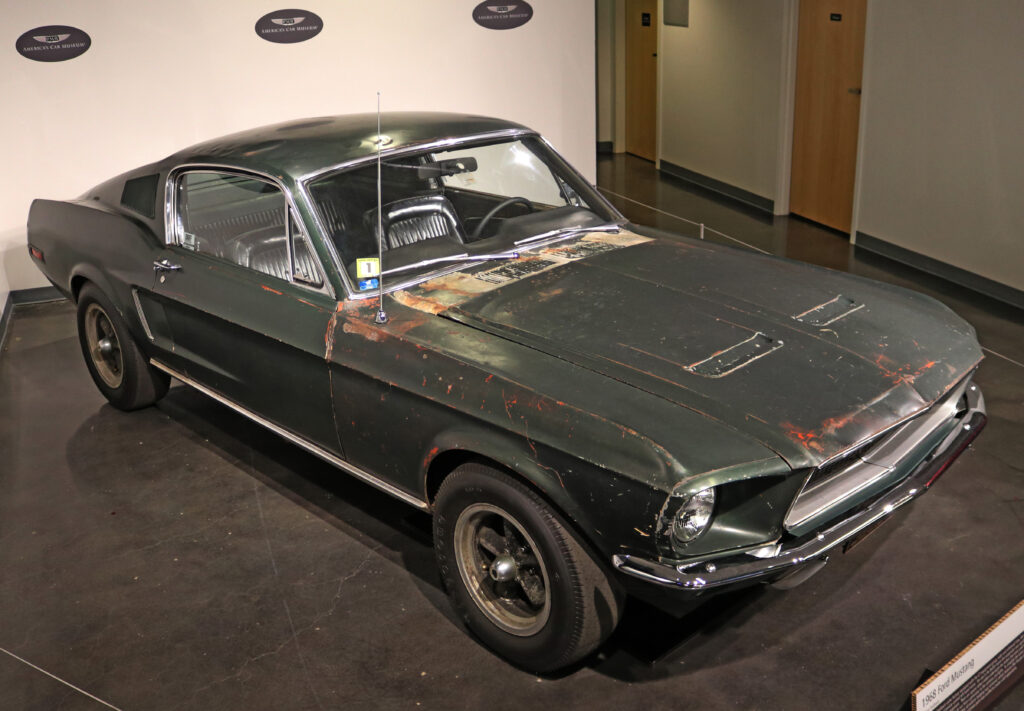
9. **McQueen’s Quest: The Unsuccessful Pursuit of His Bullitt Mustang**_The profound impact of the Bullitt Mustang on Steve McQueen himself was undeniable, a connection that transcended mere professional engagement to become deeply personal. Even years after the film’s release and despite his impressive and extensive private collection of high-performance vehicles, McQueen harbored a singular desire: to reacquire the iconic 1968 Fastback. His fascination with the car he had made famous led him on a persistent quest to track it down, eventually pinpointing the Kiernan family as its owners.
In December 1977, McQueen made his intentions clear, sending a tersely worded yet earnest letter to Robert Kiernan. He appealed directly to Kiernan, expressing his wish “to get back my ’68 Mustang” and emphasizing its singular importance to him: “it is simply personal with me.” McQueen articulated a unique desire to preserve the car in its original, unrestored condition, precisely as it appeared in the film, an unconventional preference for a celebrity collector typically drawn to pristine examples. This revealed his deep appreciation for its raw, cinematic authenticity.
McQueen even sweetened his proposition, offering to find Kiernan “another Mustang similar to the one you have,” though he somewhat dismissively added, “…if there is not too much monies [sic] involved in it. Otherwise, we had better forget it.” Despite this somewhat “charmless offer,” as it was later described, Kiernan steadfastly resisted the allure of selling the car back to its legendary driver. The letter, a remarkable piece of history, was carefully preserved by Kiernan and only came to public light alongside the car itself when the Kiernans unveiled it in 2018. Tragically, Steve McQueen died just three years after sending his final appeal in 1980, never realizing his dream of adding the Bullitt Mustang, the car he helped elevate to legendary status, to his collection.
Car Model Information: 2008 Ford Mustang GT Premium
Name: Ford Mustang
Caption: 2018 Ford Mustang GT 5.0
Aka: Ford T5 (Germany)
Manufacturer: Ford Motor Company
Production: March 1964 – present
ModelYears: 1965–present
Class: Unbulleted list
BodyStyle: Unbulleted list
Layout: Front-engine, rear-wheel-drive layout
Categories: 1970s cars, 1980s cars, 1990s cars, 2+2 coupés, 2000s cars
Summary: The Ford Mustang is an American automobile manufactured and marketed by Ford since 1964, as Ford’s longest nameplate in continuous production. Currently in its seventh generation, it is the fifth-best selling Ford car nameplate. The namesake of the “pony car” automobile segment, the Mustang was developed as a highly styled line of sporty coupes and convertibles derived from existing model lines, initially distinguished by its pronounced “long hood, short deck” proportions.
Originally predicted to sell 100,000 vehicles yearly, the 1965 Mustang became the most successful vehicle launch since the 1927 Model A. Introduced on April 17, 1964 (16 days after the Plymouth Barracuda), over 400,000 units were sold in its first year; the one-millionth Mustang was sold within two years of its launch. In August 2018, Ford produced the 10-millionth Mustang; matching the first 1965 Mustang, the vehicle was a 2019 Wimbledon White convertible with a V8 engine.
The success of the Mustang launch led to multiple competitors from other American manufacturers, including the Chevrolet Camaro and Pontiac Firebird (1967), AMC Javelin (1968), and Dodge Challenger (1970). It also competed with the Plymouth Barracuda, which was launched around the same time. The Mustang also had an effect on designs of coupes worldwide, leading to the marketing of the Toyota Celica and Ford Capri in the United States (the latter, by Lincoln-Mercury). The Mercury Cougar was launched in 1967 as a unique-bodied higher-trim alternative to the Mustang; during the 1970s, it included more features and was marketed as a personal luxury car.
From 1965 until 2004, the Mustang shared chassis commonality with other Ford model lines, staying rear-wheel-drive throughout its production. From 1965 to 1973, the Mustang was derived from the 1960 Ford Falcon compact. From 1974 until 1978, the Mustang (denoted Mustang II) was a longer-wheelbase version of the Ford Pinto. From 1979 until 2004, the Mustang shared its Fox platform chassis with 14 other Ford vehicles (becoming the final one to use the Fox architecture). Since 2005, the Mustang has used the D2C platform, unique to the Mustang.
Through its production, multiple nameplates have been associated with the Ford Mustang series, including GT, Mach 1, Boss 302/429, Cobra (separate from Shelby Cobra), and Bullitt, along with “5.0” fender badging (denoting 4.9 L OHV or 5.0 L DOHC V8 engines).
Get more information about: Ford Mustang
Buying a high-performing used car >>>
Brand: Ford Model: Mustang
Price: $16,785 Mileage: 81,832 mi.
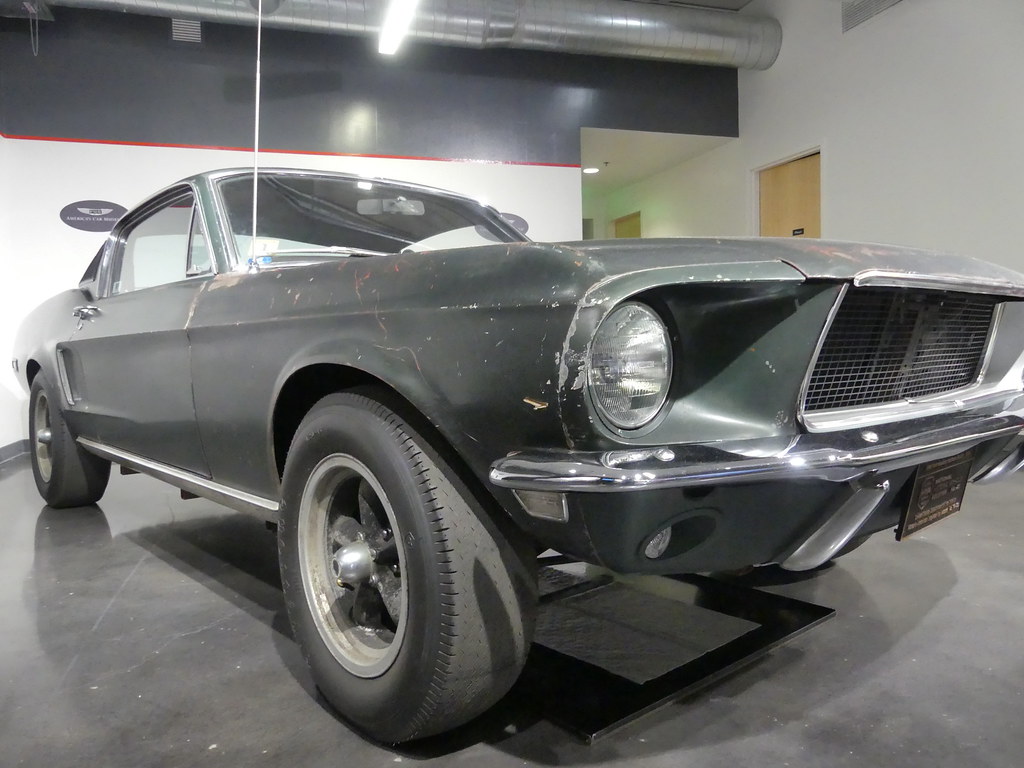
10. **The Dark Counterpart: Unmasking the Villainous Dodge Charger**No hero, no matter how iconic, can truly shine without a formidable antagonist, and in “Bullitt,” that role was masterfully filled by the menacing black 1968 Dodge Charger R/T. This powerful muscle car served as an equally integral plot element, embodying the raw, unbridled force that Frank Bullitt’s Mustang relentlessly pursued. The visual contrast between the stoic, dark green Mustang and the sleek, black Charger amplified the cinematic tension, setting the stage for an unforgettable duel of steel and rubber.
For the rigorous demands of filming, two matching Charger R/T models were employed. These formidable machines were equipped with 375-horsepower, single four-barrel 440-cubic-inch Magnum V-8 engines and four-speed transmissions, ensuring they had the raw power to match the Mustang’s performance. It is worth noting that while some rumors suggest one might have had an automatic transmission, the context confirms their potent big-block, four-speed configurations. The production opted for more conservative hubcap and whitewall rolling-stock combinations for these R/T models, a seemingly minor detail that became pivotal to the chase scene’s visual dynamics.
These choices enabled the dramatic spectacle of the Charger inexplicably “losing six hub caps” throughout the sequence, a “charming continuity goof” that has become a beloved quirk of the film. Mechanically, the Chargers received minimal modifications; torsion bars were shortened, control arms beefed up, and police-spec rear springs installed to cope with the extreme stunt work, but their powertrains largely remained stock. Like their Mustang counterparts, these cinematic villains met dramatic ends: one of the “Big Bad Dodges” was totaled in the filming of the chase’s final scene, missing the gas station set but confirming its destruction, while the other Charger was also confirmed to have been destroyed during the intense production.
Car Model Information: 2018 Chevrolet Corvette Grand Sport
Name: Dodge Charger
Caption: 1969 Dodge Charger
Manufacturer: Dodge
Production: 1966–1978,1981–1987,2005–present
ModelYears: 1966–1978,1982–1987,2006–present
Categories: 1960s cars, 1970s cars, 1980s cars, 2000s cars, 2010s cars
Summary: The Dodge Charger is a model of automobile marketed by Dodge in various forms over eight generations since 1966.
The first Charger was a show car in 1964. A 1965 Charger II concept car resembled the 1966 production version.
In the United States, the Charger nameplate has been used on mid-size cars, personal luxury coupes, subcompact hatchbacks, and full-size sedans.
Get more information about: Dodge Charger
Buying a high-performing used car >>>
Brand: Dodge Model: Charger R/T
Price: $59,896 Mileage: 26,662 mi.
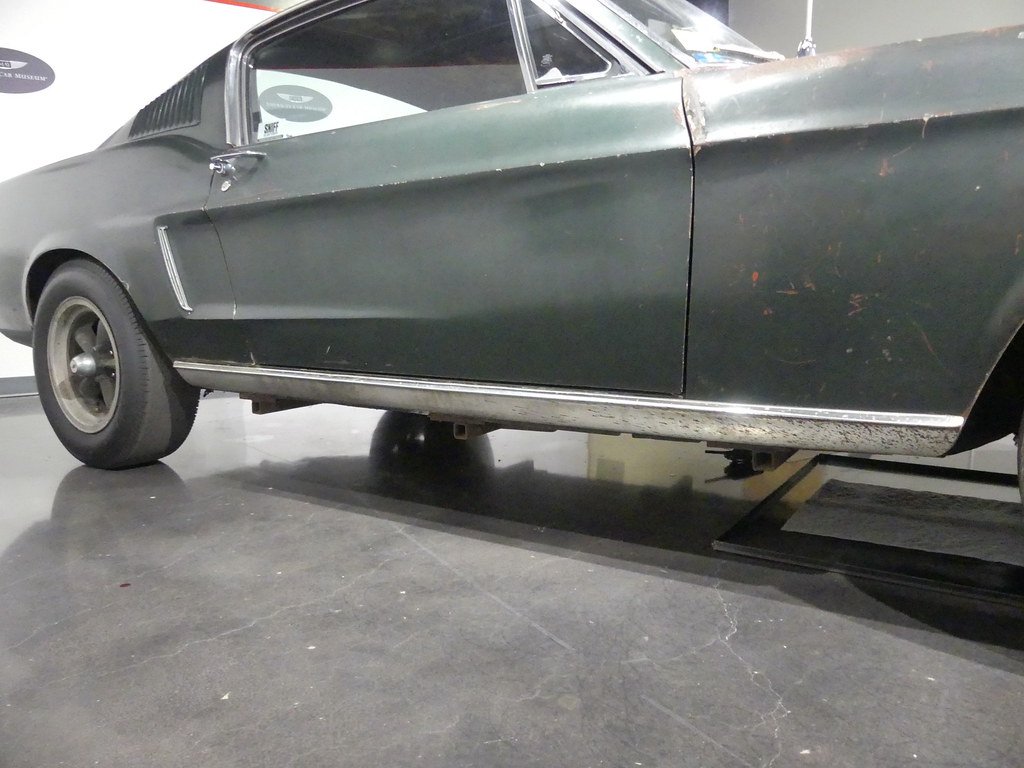
11. **The San Francisco Gauntlet: Retracing the Iconic Chase Locales**The legendary 11-minute chase in “Bullitt” is not merely a sequence of cars speeding through streets; it’s a meticulously crafted ballet set against the stunning, unforgiving backdrop of San Francisco. While the editing masterfully creates a seamless flow, the various locales are, in reality, quite disjointed, making it impossible to drive the route precisely as it appears on screen. Yet, returning to these real-world locations offers an eerie sense of connection to cinematic history, placing enthusiasts in the very tire tracks of McQueen’s iconic pursuit.
The chase primarily unfolds in the Russian Hill area of San Francisco, extending south of the city to the Guadalupe Canyon Parkway vicinity in Daly City. Our cinematic pilgrimage might begin not with the chase itself, but at the Mark Hopkins hotel, where the first San Francisco footage was shot after the story’s initial segue from Chicago. From there, we might visit Robert Vaughn’s character Chalmers’s house at 2700 Vallejo Street at Divisadero in Pacific Heights, an immaculate residence that looks much as it did in 1968, setting the stage for the narrative’s initial tensions.
Other iconic, yet disconnected, points along the “route” include the corner of Clay and Taylor streets, where Bullitt’s apartment was located, now with its ground-floor unit converted to a garage. Across the street still stands the liquor and grocery shop where Bullitt famously purchases frozen dinners and “swipes a paper” from a machine, a detail so indelible that, as the current owner notes, “People still walk up to that paper machine and pound on it.” A lone photo of McQueen hangs near the entrance, a subtle nod to the indelible memory.
The chase’s ignition point, Army Street (now Cesar Chavez Blvd.) off Highway 101, has seen changes with roadwork and the removal of the car wash, but Bimbo’s 365 nightclub on Columbus Avenue remains recognizable, mirroring its appearance through the Mustang’s windshield just as Bill Hickman, the stunt driver in the Charger, fastens his seatbelt and ignites the mayhem. Key moments like the gravity-defying jumps occur around Taylor and Filbert Street, while Larkin and Chestnut saw the Charger’s wide turn and McQueen’s famously improvised tire-smoking maneuver. The roaring pursuit along Marina Boulevard eventually leads to the fast, semi-secluded Guadalupe Canyon Parkway, the site of the motorcyclist’s spinout, completing a journey through physical locations that, even decades later, powerfully evoke the film’s enduring magic.
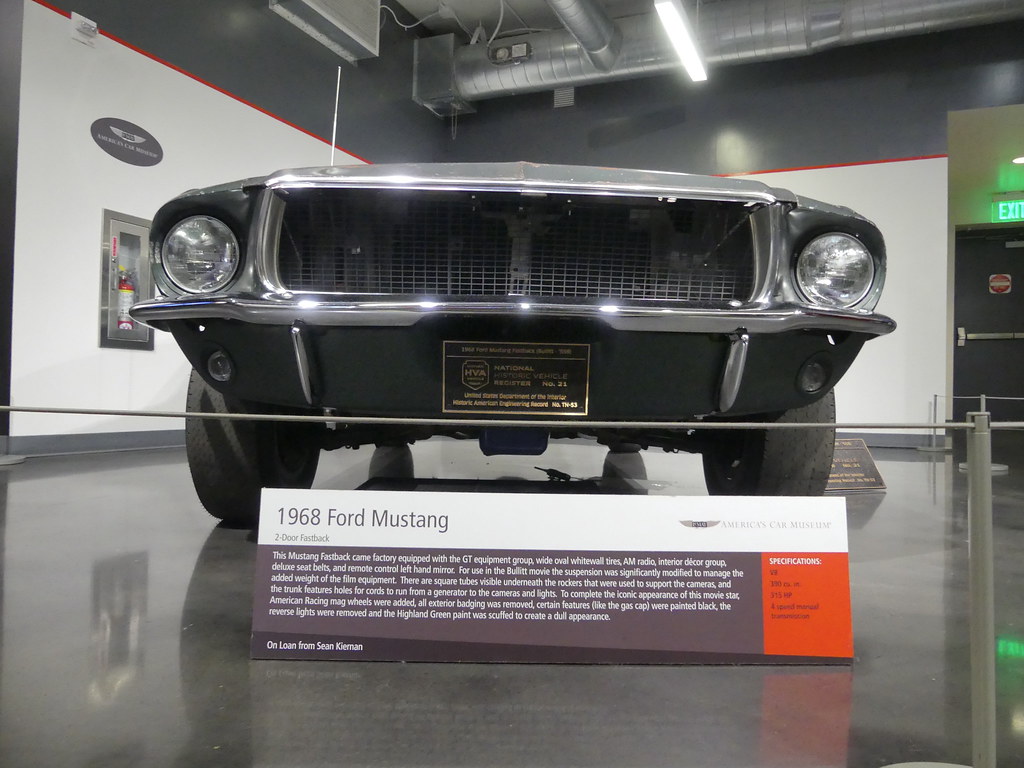
12. **Forging New Legends: Ford’s Official Bullitt Mustang Tributes**The enduring allure of the Bullitt Mustang was not lost on its progenitor, Ford, which recognized the immense cultural capital embedded in the iconic film car. Rather than letting the legend fade, Ford embraced it, launching a series of official tribute editions that allowed new generations of enthusiasts to own a piece of that cinematic history. The genesis of these modern legends began with the Ford design team, a collective of devoted Bullitt fans, who crafted a concept car for the 2000 Los Angeles Auto Show, replete with the signature Highland Green color and distinctive cues.
The response from both the public and media was overwhelmingly positive, giving Ford the green light to move from concept to production. The 2001 Bullitt Mustang was subsequently introduced, available primarily in the appropriate shade of Highland Green, though it also offered blue and black options for those seeking a different aesthetic. These special edition Mustangs were more than just a paint job; they featured minor engine modifications that amped the horsepower to 265, coupled with a beefed-up suspension for enhanced performance.
Aesthetic details were meticulously chosen to evoke the original, including brushed-metal pedals, a unique gas cap, distinctive exhaust pipes, and, notably, the inaugural use of the modern Torq Thrust-style Bullitt wheels, which truly completed the homage. These “special models” proved incredibly popular, selling “over sticker” when new, and cementing their status as sought-after collector’s items, now typically found in the $15,000 to $20,000 range. A total of 5582 Bullitt Mustangs were built, including prototypes, establishing it as a rare, one-year-only model. Adding to its authenticity and familial connection, actor and producer Chad McQueen, Steve McQueen’s son, actively participated in the car’s media launch, and the McQueen family themselves own several of these tribute editions, underscoring the deep, generational ties to the original legend.
Car Model Information: 2008 Ford Mustang GT Premium
Name: Ford Mustang
Caption: 2018 Ford Mustang GT 5.0
Aka: Ford T5 (Germany)
Manufacturer: Ford Motor Company
Production: March 1964 – present
ModelYears: 1965–present
Class: Unbulleted list
BodyStyle: Unbulleted list
Layout: Front-engine, rear-wheel-drive layout
Categories: 1970s cars, 1980s cars, 1990s cars, 2+2 coupés, 2000s cars
Summary: The Ford Mustang is an American automobile manufactured and marketed by Ford since 1964, as Ford’s longest nameplate in continuous production. Currently in its seventh generation, it is the fifth-best selling Ford car nameplate. The namesake of the “pony car” automobile segment, the Mustang was developed as a highly styled line of sporty coupes and convertibles derived from existing model lines, initially distinguished by its pronounced “long hood, short deck” proportions.
Originally predicted to sell 100,000 vehicles yearly, the 1965 Mustang became the most successful vehicle launch since the 1927 Model A. Introduced on April 17, 1964 (16 days after the Plymouth Barracuda), over 400,000 units were sold in its first year; the one-millionth Mustang was sold within two years of its launch. In August 2018, Ford produced the 10-millionth Mustang; matching the first 1965 Mustang, the vehicle was a 2019 Wimbledon White convertible with a V8 engine.
The success of the Mustang launch led to multiple competitors from other American manufacturers, including the Chevrolet Camaro and Pontiac Firebird (1967), AMC Javelin (1968), and Dodge Challenger (1970). It also competed with the Plymouth Barracuda, which was launched around the same time. The Mustang also had an effect on designs of coupes worldwide, leading to the marketing of the Toyota Celica and Ford Capri in the United States (the latter, by Lincoln-Mercury). The Mercury Cougar was launched in 1967 as a unique-bodied higher-trim alternative to the Mustang; during the 1970s, it included more features and was marketed as a personal luxury car.
From 1965 until 2004, the Mustang shared chassis commonality with other Ford model lines, staying rear-wheel-drive throughout its production. From 1965 to 1973, the Mustang was derived from the 1960 Ford Falcon compact. From 1974 until 1978, the Mustang (denoted Mustang II) was a longer-wheelbase version of the Ford Pinto. From 1979 until 2004, the Mustang shared its Fox platform chassis with 14 other Ford vehicles (becoming the final one to use the Fox architecture). Since 2005, the Mustang has used the D2C platform, unique to the Mustang.
Through its production, multiple nameplates have been associated with the Ford Mustang series, including GT, Mach 1, Boss 302/429, Cobra (separate from Shelby Cobra), and Bullitt, along with “5.0” fender badging (denoting 4.9 L OHV or 5.0 L DOHC V8 engines).
Get more information about: Ford Mustang
Buying a high-performing used car >>>
Brand: Ford Model: Mustang
Price: $16,785 Mileage: 81,832 mi.
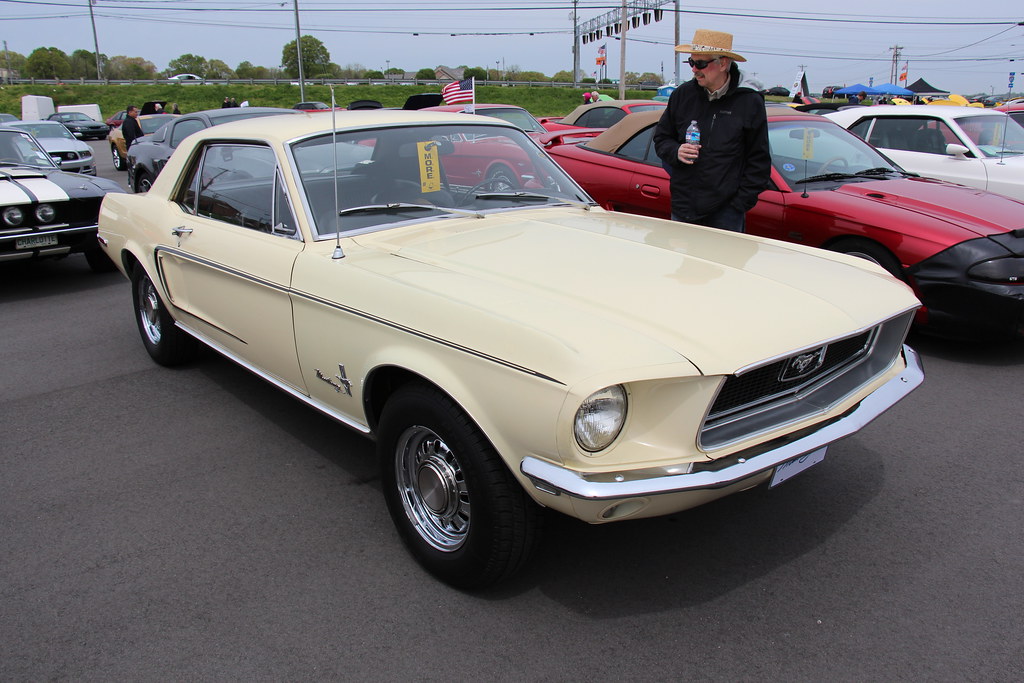
13. **The Art of Replication: Crafting Screen-Accurate Bullitt Mustangs**Beyond official tributes, the indelible image of Steve McQueen’s Bullitt Mustang has inspired countless enthusiasts to meticulously craft their own screen-accurate replicas, transforming ordinary 1967-1968 Mustang Fastbacks into tributes of cinematic perfection. This endeavor is a labor of love, demanding keen attention to detail and a deep understanding of the original film cars’ modifications. The journey of creating a faithful replica is often complex, involving specific aesthetic and mechanical alterations to capture the understated menace of Bullitt’s ride.
One of the foundational steps in achieving accuracy is the removal of all badging, including the GT and engine emblems from the front fenders, and notably, the absence of “C-stripes” and the grille-mounted horse emblem and driving lights. A 1967 grille insert, painted black, is a crucial detail. Various chrome pieces, such as the rear taillight bezels, are painted black or body color, and the individual “MUSTANG” letters on the rear are removed, with their holes filled. The exhaust system requires modification, replacing the factory split duals with two single, non-chromed pipes to replicate the authentic roar. For the true fan, black California “JJZ109” license plates are a must, though they are not legal for street use.
Wheel choice is paramount; 15-inch American Racing Torq-Thrust D wheels are considered essential for the correct look, with specific attention to the 15×6.0-inch proper rim size, rather than larger modern alternatives. The steering wheel, a 1967 Shelby “Secura” model custom-wrapped in leather by McQueen’s pal Tony Nancy, is often the most challenging piece to source or replicate, with originals commanding thousands of dollars. Enthusiasts like Dave Kunz, who painstakingly transformed his own 1968 GT 390 into a close recreation, emphasize the importance of studying the movie with freeze-frame capabilities to capture every modification. From ensuring a black interior to selecting the correct recessed rear reflectors for early 1968 models, every detail contributes to bringing the iconic Bullitt Mustang, with its unmistakable presence and storied past, to life once more.
Car Model Information: 2008 Ford Mustang GT Premium
Name: Ford Mustang
Caption: 2018 Ford Mustang GT 5.0
Aka: Ford T5 (Germany)
Manufacturer: Ford Motor Company
Production: March 1964 – present
ModelYears: 1965–present
Class: Unbulleted list
BodyStyle: Unbulleted list
Layout: Front-engine, rear-wheel-drive layout
Categories: 1970s cars, 1980s cars, 1990s cars, 2+2 coupés, 2000s cars
Summary: The Ford Mustang is an American automobile manufactured and marketed by Ford since 1964, as Ford’s longest nameplate in continuous production. Currently in its seventh generation, it is the fifth-best selling Ford car nameplate. The namesake of the “pony car” automobile segment, the Mustang was developed as a highly styled line of sporty coupes and convertibles derived from existing model lines, initially distinguished by its pronounced “long hood, short deck” proportions.
Originally predicted to sell 100,000 vehicles yearly, the 1965 Mustang became the most successful vehicle launch since the 1927 Model A. Introduced on April 17, 1964 (16 days after the Plymouth Barracuda), over 400,000 units were sold in its first year; the one-millionth Mustang was sold within two years of its launch. In August 2018, Ford produced the 10-millionth Mustang; matching the first 1965 Mustang, the vehicle was a 2019 Wimbledon White convertible with a V8 engine.
The success of the Mustang launch led to multiple competitors from other American manufacturers, including the Chevrolet Camaro and Pontiac Firebird (1967), AMC Javelin (1968), and Dodge Challenger (1970). It also competed with the Plymouth Barracuda, which was launched around the same time. The Mustang also had an effect on designs of coupes worldwide, leading to the marketing of the Toyota Celica and Ford Capri in the United States (the latter, by Lincoln-Mercury). The Mercury Cougar was launched in 1967 as a unique-bodied higher-trim alternative to the Mustang; during the 1970s, it included more features and was marketed as a personal luxury car.
From 1965 until 2004, the Mustang shared chassis commonality with other Ford model lines, staying rear-wheel-drive throughout its production. From 1965 to 1973, the Mustang was derived from the 1960 Ford Falcon compact. From 1974 until 1978, the Mustang (denoted Mustang II) was a longer-wheelbase version of the Ford Pinto. From 1979 until 2004, the Mustang shared its Fox platform chassis with 14 other Ford vehicles (becoming the final one to use the Fox architecture). Since 2005, the Mustang has used the D2C platform, unique to the Mustang.
Through its production, multiple nameplates have been associated with the Ford Mustang series, including GT, Mach 1, Boss 302/429, Cobra (separate from Shelby Cobra), and Bullitt, along with “5.0” fender badging (denoting 4.9 L OHV or 5.0 L DOHC V8 engines).
Get more information about: Ford Mustang
Buying a high-performing used car >>>
Brand: Ford Model: Mustang
Price: $16,785 Mileage: 81,832 mi.
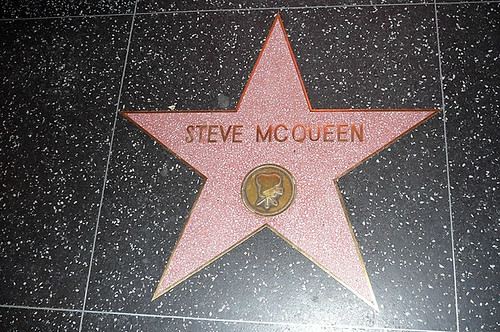
14. **The Enduring Power of Cool: Steve McQueen’s Marketing Legacy**Even decades after his passing in 1980, Steve McQueen’s image as the “King of Cool” continues to wield immense marketing power, an indelible legacy that Ford has skillfully leveraged to promote its vehicles. McQueen’s association with the Bullitt Mustang transcended the film itself, cementing a timeless connection between the actor’s rebellious spirit and the raw appeal of the muscle car. This enduring star power has allowed Ford to revisit the “Steve McQueen well” on multiple occasions, infusing new products with a dose of that inimitable cool.
One notable instance was a TV commercial for the Ford Puma, a compact sport coupe not sold in the United States. Shot in San Francisco, the ad digitally reconstituted Frank Bullitt imagery, culminating in a scene where McQueen backs the Puma into an open garage, parking it alongside a motorcycle and a 1968 Mustang Bullitt replica. This ingenious use of technology allowed McQueen to “drive” a modern Ford, bridging the generations and demonstrating the timeless appeal of his cinematic persona, despite a slight continuity quibble where the producers insisted on adding a chrome horse-and-corral to the grille, an element famously absent from the movie car.
Subsequently, when the 2005 Mustang was launched, McQueen’s likeness was again digitally merged into a commercial inspired by the movie “Field of Dreams.” Instead of building a baseball stadium in a cornfield, the commercial depicted the construction of a racetrack. An “icy” McQueen, digitized from “Bullitt” scenes, appears to take the new Mustang for a lap, giving his silent, approving nod. These campaigns underscore the rare and lasting marketing prowess of Steve McQueen’s image, proving that some legends, like the Bullitt Mustang itself, only grow more potent with time, continuing to captivate audiences and sell dreams long after their original debut.
Car Model Information: 2008 Ford Mustang GT Premium
Name: Ford Mustang
Caption: 2018 Ford Mustang GT 5.0
Aka: Ford T5 (Germany)
Manufacturer: Ford Motor Company
Production: March 1964 – present
ModelYears: 1965–present
Class: Unbulleted list
BodyStyle: Unbulleted list
Layout: Front-engine, rear-wheel-drive layout
Categories: 1970s cars, 1980s cars, 1990s cars, 2+2 coupés, 2000s cars
Summary: The Ford Mustang is an American automobile manufactured and marketed by Ford since 1964, as Ford’s longest nameplate in continuous production. Currently in its seventh generation, it is the fifth-best selling Ford car nameplate. The namesake of the “pony car” automobile segment, the Mustang was developed as a highly styled line of sporty coupes and convertibles derived from existing model lines, initially distinguished by its pronounced “long hood, short deck” proportions.
Originally predicted to sell 100,000 vehicles yearly, the 1965 Mustang became the most successful vehicle launch since the 1927 Model A. Introduced on April 17, 1964 (16 days after the Plymouth Barracuda), over 400,000 units were sold in its first year; the one-millionth Mustang was sold within two years of its launch. In August 2018, Ford produced the 10-millionth Mustang; matching the first 1965 Mustang, the vehicle was a 2019 Wimbledon White convertible with a V8 engine.
The success of the Mustang launch led to multiple competitors from other American manufacturers, including the Chevrolet Camaro and Pontiac Firebird (1967), AMC Javelin (1968), and Dodge Challenger (1970). It also competed with the Plymouth Barracuda, which was launched around the same time. The Mustang also had an effect on designs of coupes worldwide, leading to the marketing of the Toyota Celica and Ford Capri in the United States (the latter, by Lincoln-Mercury). The Mercury Cougar was launched in 1967 as a unique-bodied higher-trim alternative to the Mustang; during the 1970s, it included more features and was marketed as a personal luxury car.
From 1965 until 2004, the Mustang shared chassis commonality with other Ford model lines, staying rear-wheel-drive throughout its production. From 1965 to 1973, the Mustang was derived from the 1960 Ford Falcon compact. From 1974 until 1978, the Mustang (denoted Mustang II) was a longer-wheelbase version of the Ford Pinto. From 1979 until 2004, the Mustang shared its Fox platform chassis with 14 other Ford vehicles (becoming the final one to use the Fox architecture). Since 2005, the Mustang has used the D2C platform, unique to the Mustang.
Through its production, multiple nameplates have been associated with the Ford Mustang series, including GT, Mach 1, Boss 302/429, Cobra (separate from Shelby Cobra), and Bullitt, along with “5.0” fender badging (denoting 4.9 L OHV or 5.0 L DOHC V8 engines).
Get more information about: Ford Mustang
Buying a high-performing used car >>>
Brand: Ford Model: Mustang
Price: $16,785 Mileage: 81,832 mi.
The story of Steve McQueen’s Bullitt Mustang is far more than a mere footnote in cinematic or automotive history; it is a rich tapestry woven from the threads of personal passion, ingenious engineering, Hollywood audacity, and a touch of serendipitous fate. From its gritty on-screen performance to its dramatic disappearance and spectacular resurfacing, and through the unwavering admiration of fans and the strategic embrace by Ford, this Dark Highland Green Fastback has consistently defied the ephemeral nature of fame. It stands as a testament to the enduring power of a meticulously crafted legend, where man, machine, and myth converge to create something truly immortal, continually inspiring awe and proving that some tales, like the roar of a 390 V8, echo across generations, forever defining what it means to be cool.

